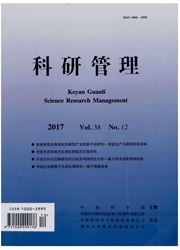

 中文摘要:
中文摘要:
根据"坚持以人为本,全面、协调、可持续发展"的科学发展观内涵,通过指标的海选和筛选构建了适合于中国省级行政区的科技评价指标体系。根据科技投入、科技产出、科技对经济的影响、科技对社会的影响等评价准则,利用离差最大化方法为指标赋权,利用灰色关联度为指标打分,建立了基于灰色关联分析的科技评价模型。利用Ward聚类分析了中国区域科技发展的特征。本文的特色与创新一是通过建立反映全面协调与可持续发展的指标体系,使科技评价符合科学发展观的要求。二是通过对14个典型省份的Ward聚类,揭示了中国科技发展的地域不平衡特征。三是通过离差最大化方法客观地确定指标权重,避免了人为主观确定权重的随意性。四是采用便于横向对比的指标"专利授权数"替换"专利授权率",避免了评价中科技发展水平低的地区专利申请和授权数都低,专利授权率反而较高的现象。
 英文摘要:
英文摘要:
According to the meaning of scientific development concept,namely,insisting on human-oriented,comprehensive,coordinated and sustainable development,the science and technology evaluation indicators system suited for provinces in China is constructed through the selecting and screening of science and technology indicators.According to the evaluation guidelines which include input of ST,output of ST,the influence of ST on economy,the influence of ST on society,the maximizing deviations method is used to give weights to each indicator,the grey relational analysis is adopted to give scores to each indicator,an evaluation model is set up based on grey relational analysis.Ward cluster is employed to analyze the regional characteristics of 14 typical provinces in China.The main contributions of the study lie on four aspects: firstly,the science and technology appraising indicator system which represents the meaning of comprehensive,coordinated and sustainable development is sep up to reflect the principle of scientific development view.Secondly,ward cluster is used to find out the non-balance character of China's regional science and technology development.Thirdly,the maximizing deviations method is employed to give weights to each indicator in order to avoid the randomness caused by ensuring the weights subjectively.Fourthly,the indicator patent authorization amount is adopted to substitute patent authorization ratio to avert from the phenomenon existing in undeveloped regions that both the patent application amount and patent authorization amount are low,however the patent authorization ratio is high.
 同期刊论文项目
同期刊论文项目
 同项目期刊论文
同项目期刊论文
 期刊信息
期刊信息
